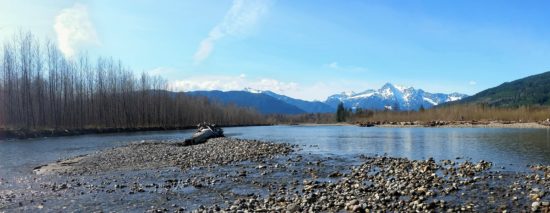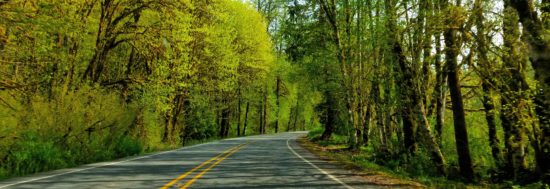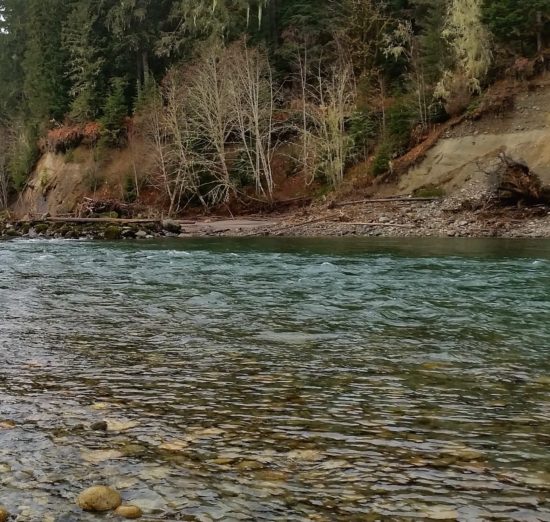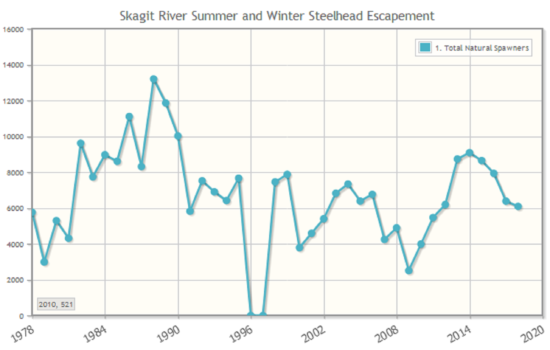
Thoughts On The Cancellation Of Skagit-Sauk C&R Steelhead Season
Like many North Sound steelheaders, I’m disappointed with this week’s news that not enough wild winter-runs are forecast to return to the Skagit and Sauk this year to support another catch-and-release opener.

I’m also frustrated, given how much effort that I saw fellow anglers as well as state and tribal biologists and managers put into convincing federal overseers to approve the North Cascades fishery.
And angry because after just a season and a sixth on these vaunted waters in the entirety of last decade — a mere 101 days of opportunity — me and a whole lot of other devotees are right back on the bank again.
Just like where we were in January 2010.
So much for making the run out to Darrington, floating down from Marblemount, or swinging spoons or flies near Rockport and Concrete this February, March and April.
So much for another million dollars for the region, like what last season generated –$22 and change from me alone after lunching up at the IGA in the home of the Loggers.
So much for rejuvenating one’s self in the beautiful solitude of this country as winter ebbs into spring and snowfields glisten under blue skies and the willows bud and the grouse drum.

Now, I am not going to sit here and pretend that I am the most aggrieved Sauk-Skagit steelheader of all time.
Yes, I have been fishing here occasionally since, I want to say, the early 2000s, but most others have far longer histories with these waters, and needless to say far, faaaaaaaar more catches.
Hell, the last thing I caught out of these rivers was a scolding last April Fools’ Day for parking in a known tweeker den so I could fish a certain run!
But I have been writing about it and the rest of Puget Sound steelheading’s highs, lows and woes over the past decade or so, and this feels like a bitter blow.
For want of a measly 38 fish …
Thirty-eight.

THE PROBLEM, AS EVERYWHERE ANYMORE, is that not enough fish are returning to hold a season, and since these happen to also be listed under the Endangered Species Act they require significant protection on their road to recovery.
This year’s forecast calls for just 3,963 natives, which essentially is too few because of incidental impacts that will occur to them in other fisheries.
Overlapping the run to various degrees are state and tribal seasons targeting blackmouth, spring Chinook, sockeye and bull trout, and they have their own devotees.
The winter-spring native fishery is operated under April 2018’s Skagit River Steelhead Fishery Resource Management Plan and uses a “stepped” impact rate, which is to say that the more fish that are predicted to return, the more that can removed one way or another from the population.
Think those incidental impacts elsewhere, and catch-and-release handling mortalities and tribal harvest that are allowed under the federal permit.
To be clear, the three Skagit Basin tribes that went in with WDFW on the management plan will not be harvesting wild steelhead this season while we state anglers are shut down.
With runs of 8,001 or more fish, the impact rate is up to 25 percent ; for runs between 6,001 and 8,000, it’s 20 percent; for runs between 4,001 and 6,000 it’s 10 percent; and when it’s 4,000 or fewer, the rate drops to just 4 percent, which as it stands gets eaten up by other fisheries.
So mathematically it’s all quite simple, actually.

BUT SCRUBBING THE SEASON WAS NOT AN EASY decision for WDFW to make, I understand.
There was the weight of the considerable time and energy that the fishing public and agency invested in getting it off the ground again — the grassroots effort known as Occupy Skagit, the institutional buy-in from staff and the Fish and Wildlife Commission, having three separate tribal nations on board, writing the plan, putting it out for comment and then getting the nervous nellies at the National Marine Fisheries Service to approve the damn thing already.
There was the forecast, soooooooo close to the line and coming at a time when any fish prediction is immediately suspect — especially given the pretty crazy new signals the North Pacific is throwing off with the rise of The Blob.
There was the low expected return of 5-year-olds, a class that typically makes up a very strong plurality of any given season’s return.
There were the almost uniformly poor early hatchery steelhead returns from southern mainland British Columbia down through Puget Sound and on the Washington Coast and Lower Columbia tribs — were those a sign of ocean productivity that could be applied to wild runs?
And there’s the fact that WDFW has been using the Skagit-Sauk season as a key example of what it calls “emergent needs” and requires a budget boost of somewhere around a couple hundred thousand bucks to perform the heavy monitoring required under the permit from NMFS because of the listing.
Throw in the watchful eyes of NMFS, and undoubtedly a lawsuit sitting on the Wild Fish Conservancy’s fax machine just waiting for Kurt Beardslee to hit send, and, well … I’m damn glad I wasn’t the one being paid to make the decision.

ULTIMATELY, STEWARDSHIP WON OUT and I can respect and support that.
There is a lot riding on Puget Sound’s last best stock. Under NMFS’s new recovery plan, it’s one of four separate winter steelhead populations in the North Cascades that to delist must meet set escapement goals — 15,000 in the case of the Sauk-Skagit.
Yes, there’s a long way to go, but if this year’s forecast is actually correct, it would still be 1,000 and 1,400 more wild steelhead back to the system than the next two lowest runs: 1979’s 2,982 and 2009’s 2,502.

A WDFW graph shows that those years were ultimately followed by large increases in run sizes; following the last nadir it jumped to 8,727, 9,084 and 8,644 in back-to-back-to-back years in the mid-2010s.
With good habitat in the headwaters and lots of restoration work ongoing elsewhere, carrying capacity will increase more.
Hell, if we were patient enough to sit on the bank for the eight straight seasons that a fishery wasn’t even on the table — 2010 through 2017 — what’s another year?
The wild card, though, is just how much damage The Blob wrought as it dewatered tributaries and overheated streams onshore and affected the foodweb offshore, potentially impacting a handful of year-classes.
Another year could become two, three years … more?
We’re patient, we steelheaders are, but the state of affairs with our favorite winter pastime in Pugetropolis is beyond aggravating.
The continual grinding loss of opportunities over the decades, the declining runs, the listing, the reduction in hatchery releases, pinnipeds and lawsuits eating away at the scraps that are left …
Joining our feelings of disappointment, frustration and anger is sheer utter hopelessness. We can’t take any more. The problem for the fish is so huge. Why did you ever let us start steelheading in the first place if it was all going to go to sh*t, oh lord?
God, maybe Phil Anderson should have just put us out of our misery back in 2010 when he broached the idea of “eliminating steelhead fishing in Puget Sound” in response to his agency’s budget woes.
As we know (and do we ever know), those woes are still around.
And yet while everything else has seemingly bled out, Skagit-Sauk wild steelhead are still around.
They’re an amazingly strong stock, a plastic absurdity of a fish– those in the Skagit Basin exhibit nearly 36 different life histories, three @#$%@$# dozen!
They will cycle back up and along the way be better able to adapt to the changing conditions in so many of their habitats.
One of which I occasionally visit in winter and spring, float and spoon rods in hand as bull ruffies drum up mates and the smell of cottonwood sap fills my nostrils.

